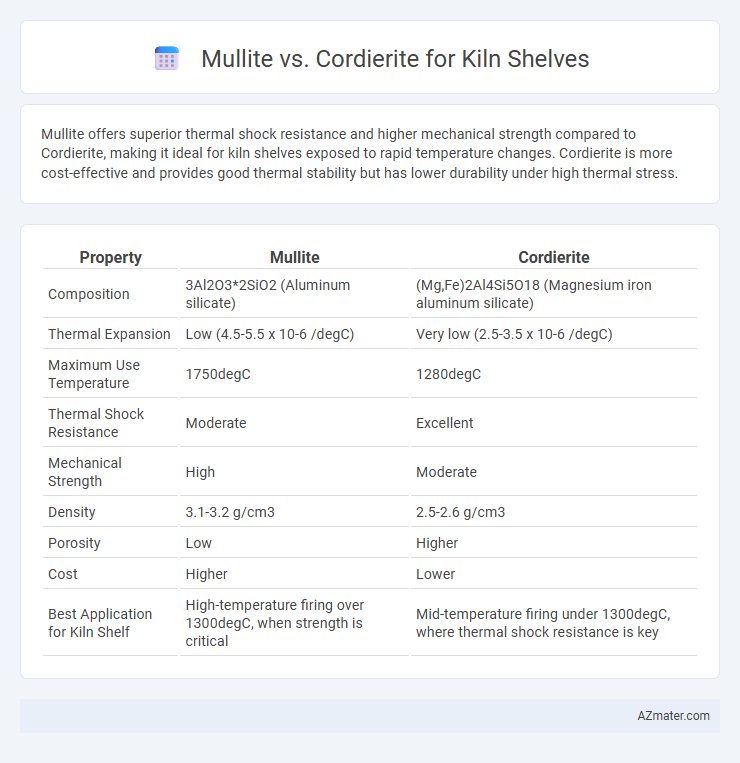Mullite offers superior thermal shock resistance and higher mechanical strength compared to Cordierite, making it ideal for kiln shelves exposed to rapid temperature changes. Cordierite is more cost-effective and provides good thermal stability but has lower durability under high thermal stress.
Table of Comparison
| Property | Mullite | Cordierite |
|---|---|---|
| Composition | 3Al2O3*2SiO2 (Aluminum silicate) | (Mg,Fe)2Al4Si5O18 (Magnesium iron aluminum silicate) |
| Thermal Expansion | Low (4.5-5.5 x 10-6 /degC) | Very low (2.5-3.5 x 10-6 /degC) |
| Maximum Use Temperature | 1750degC | 1280degC |
| Thermal Shock Resistance | Moderate | Excellent |
| Mechanical Strength | High | Moderate |
| Density | 3.1-3.2 g/cm3 | 2.5-2.6 g/cm3 |
| Porosity | Low | Higher |
| Cost | Higher | Lower |
| Best Application for Kiln Shelf | High-temperature firing over 1300degC, when strength is critical | Mid-temperature firing under 1300degC, where thermal shock resistance is key |
Introduction to Kiln Shelf Materials
Kiln shelves are essential components in ceramics and glass firing processes, requiring materials that withstand high temperatures and thermal shock. Mullite, with its high alumina content and excellent thermal stability, offers superior resistance to deformation and cracking during repeated firings. Cordierite kiln shelves provide lightweight durability and exceptional thermal shock resistance but have lower maximum service temperatures compared to mullite, making the choice dependent on specific firing conditions and temperature ranges.
What is Mullite?
Mullite is an alumino-silicate ceramic renowned for its high thermal stability, low thermal expansion, and excellent resistance to thermal shock, making it ideal for kiln shelves in high-temperature applications. Comprising primarily 3Al2O3*2SiO2, mullite forms through the firing of kaolin clay at temperatures above 1300degC, resulting in a dense, durable structure that withstands repeated heating and cooling cycles. Its superior mechanical strength and chemical inertness contribute to enhanced kiln shelf longevity compared to materials like cordierite.
What is Cordierite?
Cordierite is a magnesium iron aluminum cyclosilicate ceramic known for its excellent thermal shock resistance and low thermal expansion, making it ideal for kiln shelves. It can withstand rapid temperature changes without cracking, surpassing many other kiln shelf materials in durability and performance. This combination of properties allows cordierite kiln shelves to endure repeated heating and cooling cycles, enhancing kiln efficiency and longevity.
Key Physical and Thermal Properties
Mullite kiln shelves exhibit higher mechanical strength and superior thermal shock resistance compared to cordierite, making them suitable for extreme firing conditions up to 1750degC. Cordierite offers lower thermal expansion (around 2.5 x 10^-6 /degC) which enhances dimensional stability and reduces warping during rapid temperature changes, with a maximum continuous use temperature around 1280degC. Both materials provide excellent resistance to thermal fatigue, but mullite's higher density and hardness increase its durability in aggressive kiln environments.
Strength and Durability Comparison
Mullite kiln shelves exhibit superior thermal shock resistance and higher mechanical strength, making them ideal for prolonged high-temperature firing cycles. Cordierite shelves offer excellent resistance to thermal expansion and are highly resistant to cracking under rapid temperature changes, supporting durability in less extreme firing conditions. The choice between Mullite and Cordierite depends on the specific kiln environment, with Mullite preferred for heavy-duty industrial use and Cordierite favored for hobbyist or mid-range applications.
Thermal Shock Resistance
Mullite kiln shelves exhibit superior thermal shock resistance due to their high alumina content and stable crystalline structure, allowing them to withstand rapid temperature changes without cracking. Cordierite shelves offer good thermal shock resistance as well, but they are more prone to thermal expansion and potential warping under extreme temperature fluctuations. For applications requiring frequent heating and cooling cycles, mullite kiln shelves provide enhanced durability and longevity compared to cordierite alternatives.
Weight and Handling Differences
Mullite kiln shelves are heavier and denser, providing superior strength and thermal shock resistance but making them more cumbersome to handle and transport. Cordierite shelves are lighter and more lightweight, which enhances ease of handling and installation while still offering good thermal shock resistance and durability for most firing processes. The choice between mullite and cordierite shelves often depends on the need for durability versus portability in kiln operations.
Cost Considerations
Mullite kiln shelves generally cost more than cordierite due to their higher purity and superior thermal shock resistance, making them a long-term investment for frequent high-temperature firings. Cordierite shelves are more affordable initially and offer excellent thermal shock resistance but may require replacement sooner under extreme firing conditions. Choosing between mullite and cordierite depends on balancing upfront cost with durability and firing frequency to optimize overall expenses.
Best Applications for Mullite Shelves
Mullite kiln shelves excel in high-temperature applications due to their superior thermal shock resistance and strength at temperatures up to 1800degC, making them ideal for porcelain and stoneware firing. Their low thermal expansion and excellent resistance to crazing and warping ensure precise dimensional stability during repeated firings. Industries focused on ceramics requiring high firing temperatures and durability, such as advanced technical ceramics and fine china production, benefit significantly from mullite shelves.
Best Applications for Cordierite Shelves
Cordierite kiln shelves excel in applications requiring high thermal shock resistance and durability, making them ideal for rapid heating and cooling cycles in ceramics and glass fusing. Their lower thermal expansion and lightweight properties reduce warping and improve energy efficiency during firing. Cordierite shelves are particularly favored for intricate glasswork, porcelain, and delicate ceramic pieces where minimizing thermal stress is critical.

Infographic: Mullite vs Cordierite for Kiln shelf
 azmater.com
azmater.com